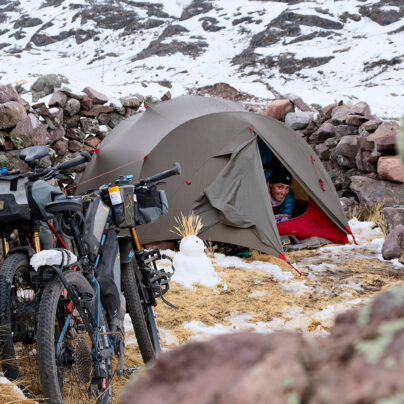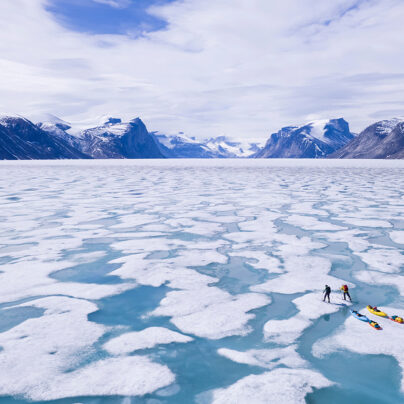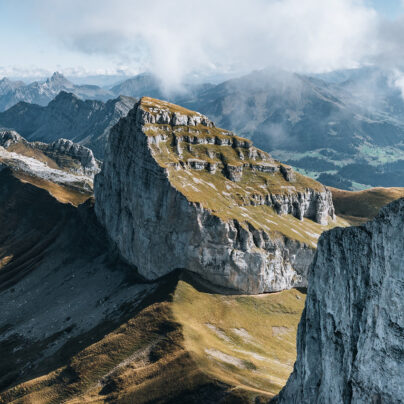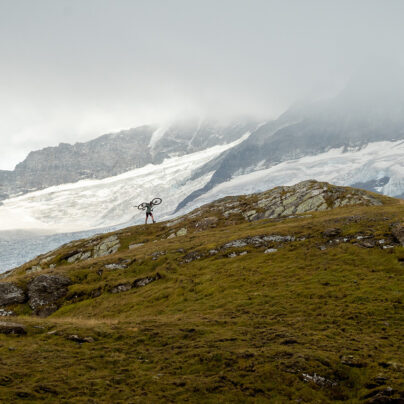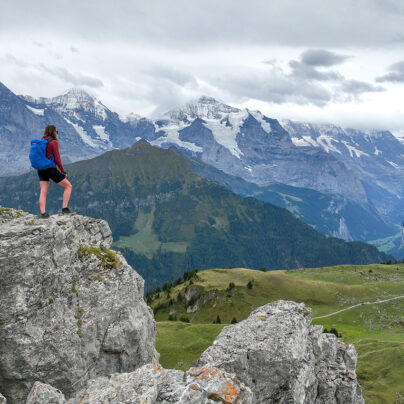No Excuses
Exploring the wilderness of the Brooks Range, Alaska
Adam Parkison
On the northern fringes of Alaska, only truly witnessed during a two-month window of warm weather, there is a land larger than dreams. Rolling green tundra, dominated by charcoal black mountain peaks carved from ice. A carpet of blue berries under foot and a collage of unique fauna only recently evolved from the Pleistocene. On any given day, the hills might be crawling with thousands of caribou on their ancient migration path, with wolves stalking them from the rear. Dall sheep and barren-ground grizzlies might be spotted in the mountain valleys and crags. Perhaps even Muskoxen, or a silent polar bear hunting on the northern flats. For the adventurous, this arctic tundra is a near limitless playground of pristine wilderness.
Too long I had made excuses for not making the trip to Alaska’s Brooks Range. I reasoned that the only way to properly appreciate the splendour of the region was through a lengthy, carefully planned expedition, with logistical details cemented – a remote drop-in by bush plane and strategically placed food caches along the route. Though I would love to experience the arctic by such ‘luxurious’ means, the stark reality of my financial situation was far less accommodating. With no sponsorship or large expedition experience under my belt, I needed to be more thrifty in attaining my goal of backpacking arctic Alaska. Yet still this childhood fantasy tugged at my dreams, and after years of putting the trip on hold, I finally decided I couldn’t wait any longer.
Feeling somewhat older than my 25 years, and not wanting another August to come and go without seeing the Brooks Range for myself, I finally booked a flight from my home in Bozeman, Montana to Fairbanks, Alaska. I hitched a ride on the Dalton Highway Express, a shuttle service running up the remote Dalton Highway – a gravel track known locally as the ‘Haul Road’. I was to be dropped off at a designated point, where I would then be picked up two weeks later. During those two weeks, I would have over 19 million acres of wilderness within the Arctic National Wildlife Refuge to play in.
Standing alone on the side of a gravel road, watching my ride disappear in a cloud of thick dust, the daunting realisation of my journey suddenly struck me. Gathering the last vestiges of my remaining courage, I took tentative steps onto the spongy tundra. Soon I was soon completely immersed in this vast wilderness. I discovered early in the first week, after obsessing over food stocks and calculating my caloric need, that I was in dangerously short supply. To make matters worse, on the journey up, at the last mark of civilisation – a place called Coldfoot Camp, a truck stop 140 kilometres to the south – I had purchased a huge cookie that I’d inexplicably devoured in one go. Later, having had to painstakingly ration out my short supply of dehydrated food, that cookie preyed on my mind incessantly.
Standing alone on the side of a gravel road, watching my ride disappear in a cloud of thick dust, the daunting realisation of my journey suddenly struck me. Gathering the last vestiges of my remaining courage, I took tentative steps onto the spongy tundra.
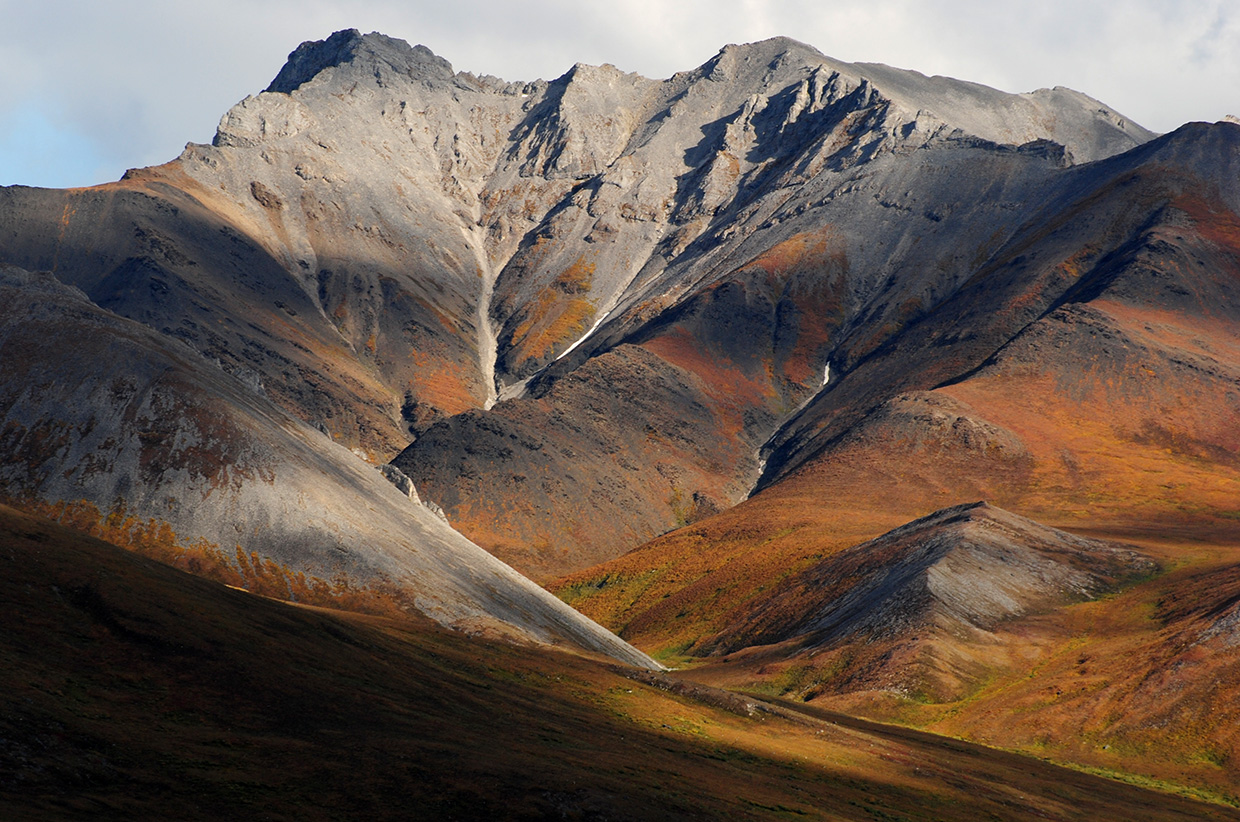
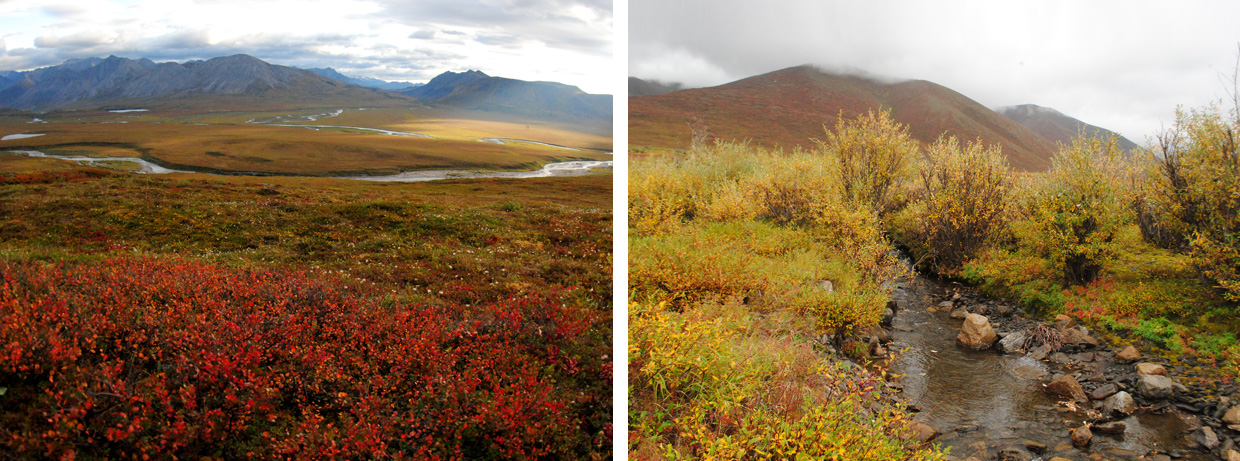
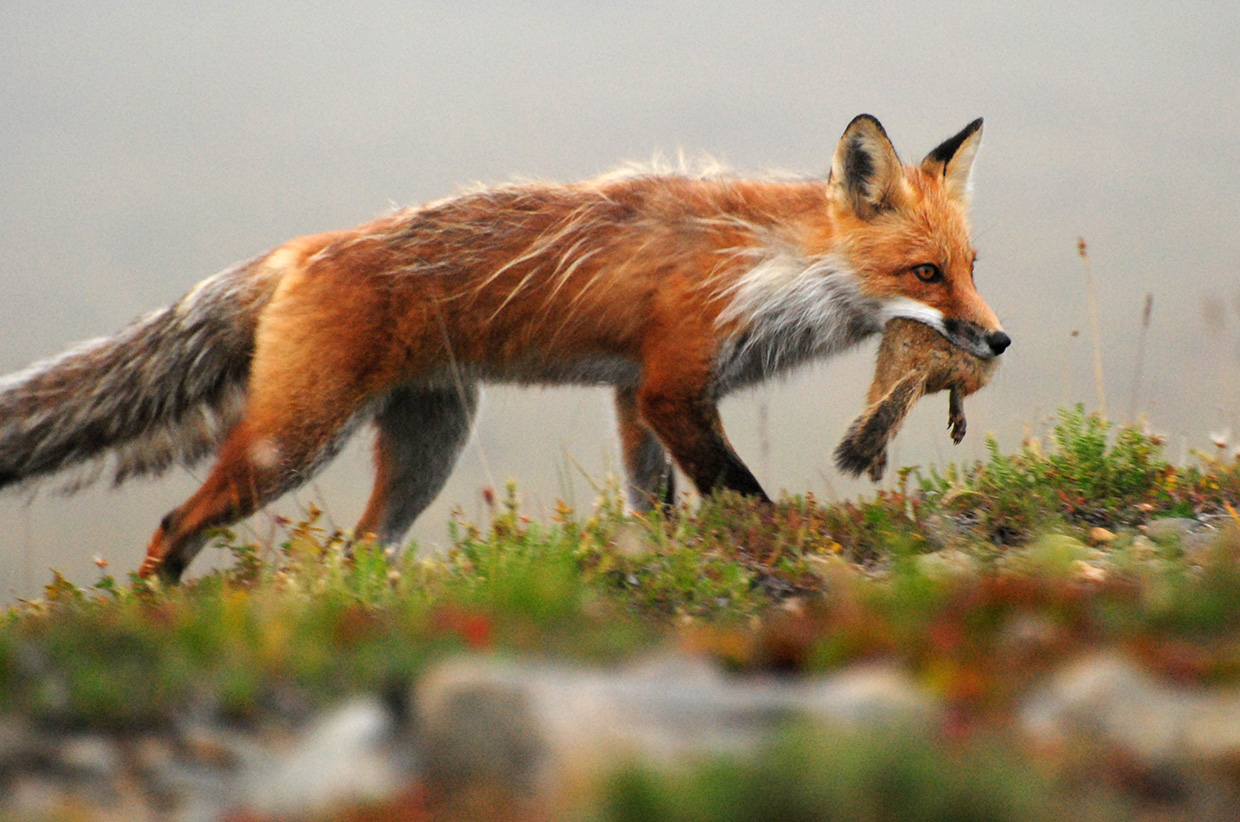
For the first few days, the sky was clear and the sun burned white hot. Mosquitos attacked me in swarms. I prayed for the cold relief of rain, but I really should’ve been careful what I wished for.
The walk was every bit as challenging as I’d anticipated. For the first few days, the sky was clear and the sun burned white hot. Mosquitos attacked me in swarms. I prayed for the cold relief of rain, but I really should’ve been careful what I wished for. When it eventually did start to rain, it didn’t stop for days, and it became a challenge to keep my down jacket and sleeping bag manageably dry. At night, I shivered inside perpetually damp clothes. I found what veteran Alaskan explorers have preached continuously: pack the best rain gear you can afford.
At the very end of that first week, I summited to a superb mountain vista of the high peaks fading into the endless coastal plains of the Arctic Ocean. I had skirted so many unnamed peaks, descended into lonely valleys, and crossed a handful of waist-deep rivers – all on my own. With over one hundred kilometres behind me, I knew sadly the time had come for me to turn back.
Despite the pleasant spirits that inevitably accompany an adventure as it unfolds, something still nagged at me – an experience yet to be fulfilled. Apart from the rewards of a big, solo backpacking trek, I had other ambitions for the journey. As a general theme, I frequently try to take trips where interesting wildlife can be found. Armed with substantial camera gear, I hoped to record the vivid wildlife found in the region.
I had become acquainted with many of the arctic’s colourful characters that first week, including a lone caribou bull high on a plateau one day, and throughout the journey I had shared constant companionship with brilliant white Dall sheep in the cliffs above. The most exciting experience up to that point had come when a dense fog wrapped itself around my camp one evening, and out of the mist emerged a ghostly auburn fox with a ground squirrel in its mouth. The region’s bird life remained largely elusive, but provided sporadic moments of excitement – one afternoon I watched a golden eagle touch off for a hunting expedition from a cliff over raging rapids, where merganser ducks waded below. Most days, a lone peregrine falcon could be seen hunting small rodents in the endless tundra.
Even when no animals were in sight, their presence was always felt – walking across one muddy river bed, I found fresh caribou tracks fleeing into the distance, with a clutch of even fresher wolf tracks behind those. Caribou and moose horns – discarded and weather-worn – littered the tundra landscape in all directions. Despite the rewarding animal encounters up to that point, I still felt I needed to meet and photograph one more arctic resident before I could call the trip a success. I wanted more than anything to meet a barren-ground grizzly bear.
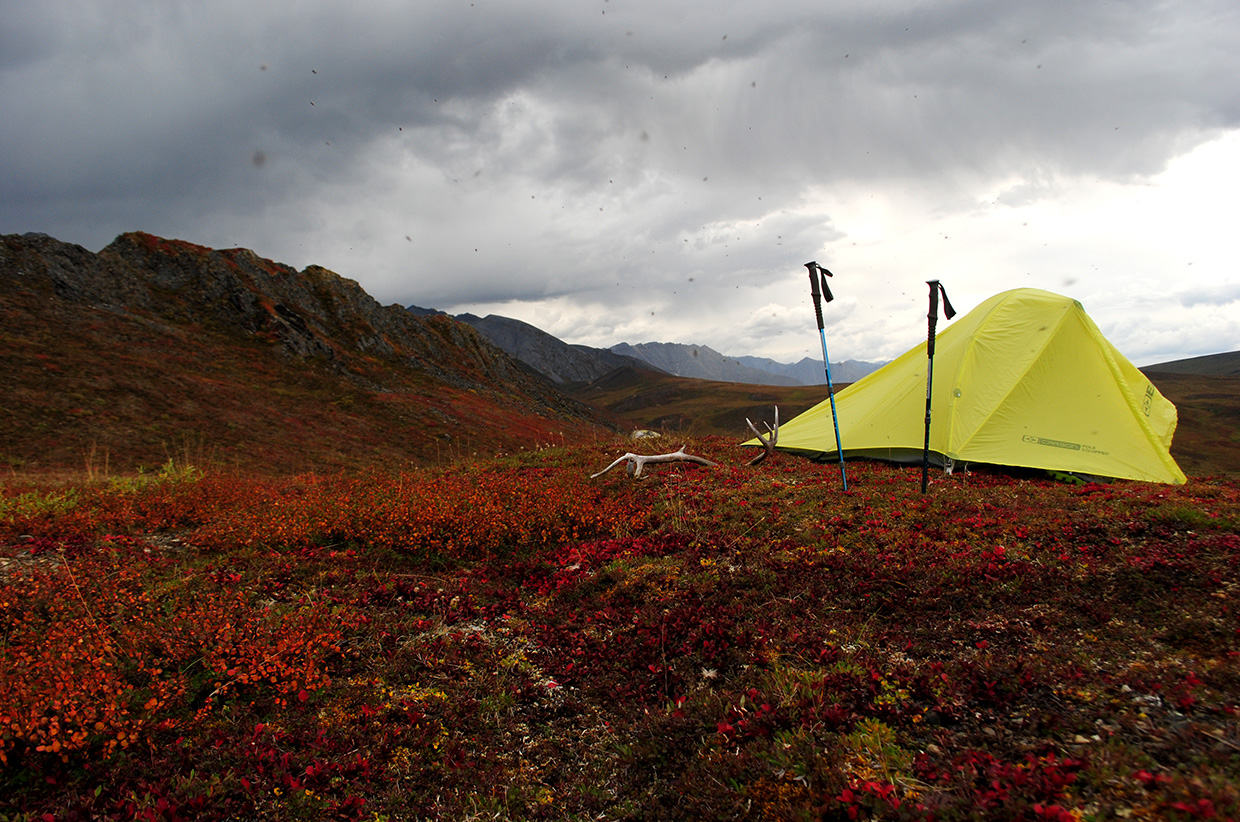
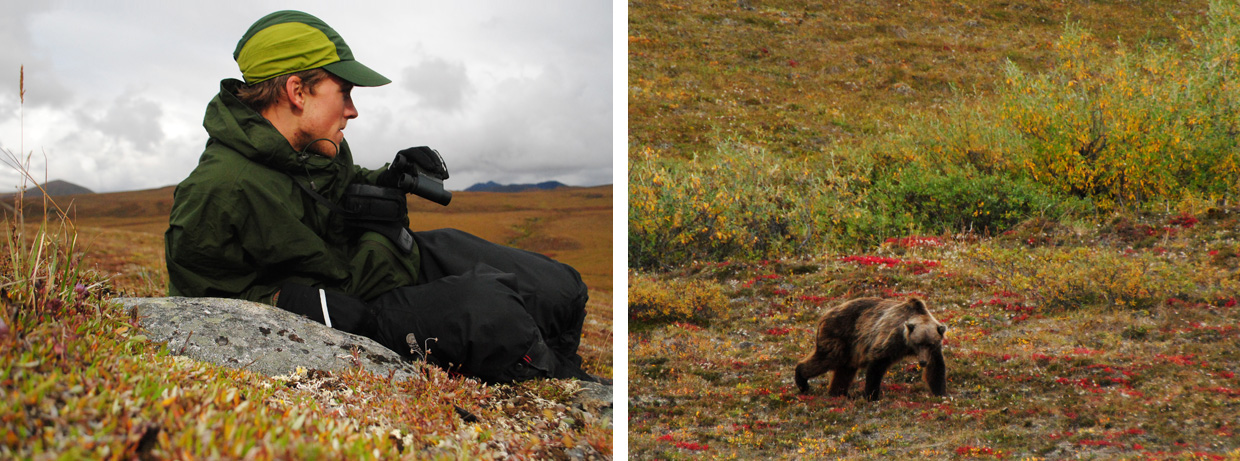
One afternoon, nearing the end of my journey, I chose a rocky outcrop overlooking a vast valley floor as my home for the night. All afternoon, grey clouds rolled in like waves, throwing sheets of drizzle onto my small camp. The valley filled then emptied of dense fog through the next few hours. In a misty break in the pall, I caught sight of a dark blob suddenly appear in a stand of dwarf birch below my camp. Before I had time to properly identify the mysterious shape, it had vanished.
Even though I could not see very well, something in my gut told me it was a bear. I clambered down the hill toward where I had seen the silhouette. About 300 meters away, I curled up next to a large boulder, with my camera rested on my lap, and the long waiting game began.
I remained there, frozen, for more than three hours. I’m not sure where such patience or resolve came from, but eventually the shape suddenly appeared again. Pulling up my binoculars, I saw the big, brown face of an arctic grizzly staring out from between dwarf birch. After shaking off rain water, the bear stood on all fours, revealing its huge frame.
Before she – I say that because I had a curious hunch it was a sow – could move too far out in the open toward my right, I crept forward behind boulders and bushes, and over a small hill, in an attempt to draw silently closer. Crawling over a steep rise, I peered into the opening in the tundra and found the bear less than 120 metres away, feeding on roots and berries. I began snapping photos with trembling hands.
I am not naive to the hazards of creeping up to a predator. Nine years before, not terribly far from the area I was exploring, an American couple – Anchorage residents – had been killed by an arctic grizzly. And just a few months before this trek, in my home in the mountains of south-west Montana – a region known for bear attacks over the years, including a few fatalities from grizzlies – I had received a close call when a grizzly came into my campsite one night, and walked within eight steps of my tent.
Crawling over a steep rise, I peered into the opening in the tundra and found the bear less than 120 metres away, feeding on roots and berries. I began snapping photos with trembling hands.
Keeping the wind in my face to lessen the chance of the bear smelling me, I continued to follow it on its foraging expedition, sharing an intimate few hours with this queen of the arctic. When she climbed a rise, and disappeared into the brush on the other side, I knew our time was over. I fairly stumbled back to my camp, lingering adrenaline leaving me with tingling limbs. I had finally captured images of the arctic grizzly bear, and my main ambition for the trip had been fulfilled. I felt a sense of huge satisfaction.
And then, like a bad dream, a couple short days later I emerged onto the remote gravel road from whence I started my adventure 12 days before. Stumbling into a near vacant Galbraith Lake campsite, hair tousled, unshaven, I startled a group of tourists on a guided overland journey, who probably mistook me for some deranged hermit. But before long, I was invited to campfire circle and, within a couple hours, well fed. At night’s closing, before I could leave for my own tent, my new tourist friends opened up a big ice chest and revealed a well-received reward for my two-week effort – ice cold beer.
After traveling extensively throughout central Africa the last five years, Adam Parkison has recently embarked on a new adventure of freelance magazine writing and photography. Adam lives in south-west Montana with his wife and two small children- who all share an equal love in wild pursuits. While not training and competing in ultramarathons, Adam still finds a way to disappear in the mountains on solo backpacking treks whenever he can.
Website: www.adamparkison.com
Blog: footravel.wordpress.com
